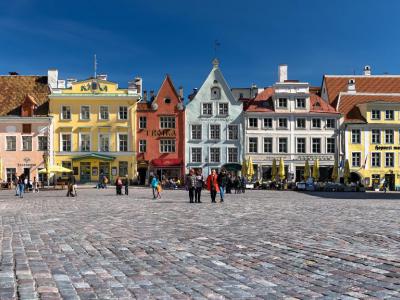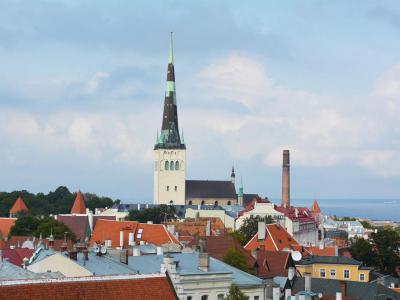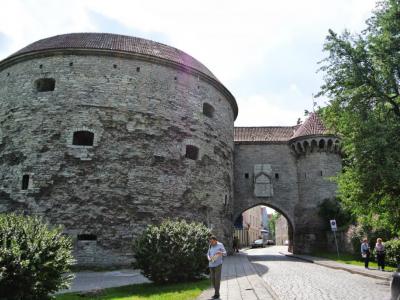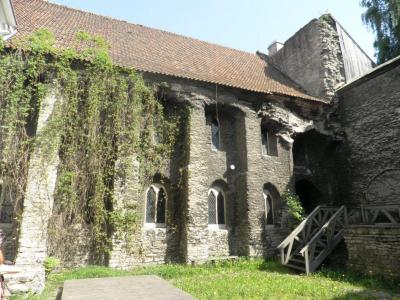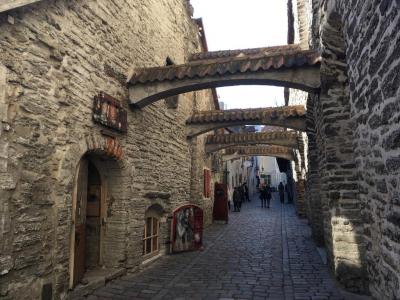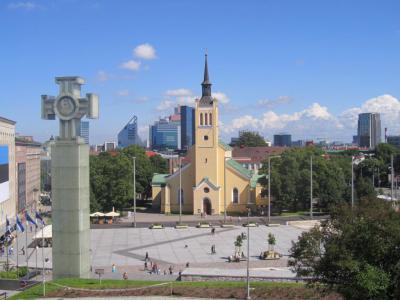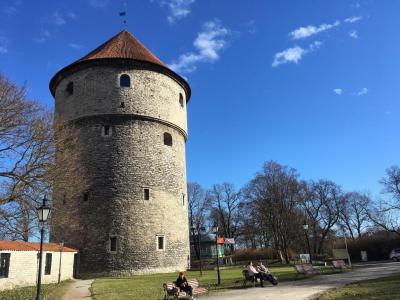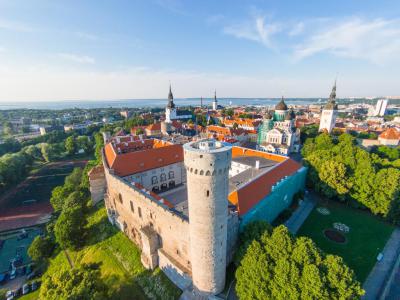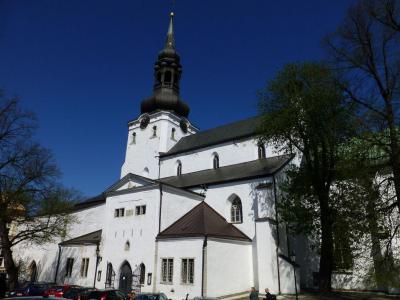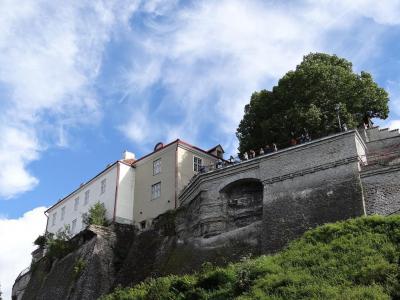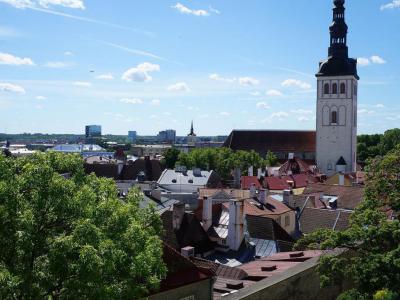Tallinn Introduction Walking Tour (Self Guided), Tallinn
Estonia’s capital Tallinn is the country’s largest city and cultural hub. One of the biggest ports on the Baltic Sea, the area has been known for its convenient harbor since as early as the 10th century. Owing to its strategic location for trade between Russia and Scandinavia, the Kingdom of Denmark laid claim on this land in 1219. The city itself, first mentioned in 1154, was incorporated in 1248.
From the 13th century until 1918 Tallinn went by its historical German name Reval. The current name – Tallinn – of Estonian origin is thought to be derived from Taani-linn(a), which means “Danish-town”, after the Danes built a castle in place of the Estonian stronghold at Lindanisse.
In 1346 the king of Denmark sold Reval, along with other possessions in northern Estonia, to the Teutonic Knights. During the Great Northern War, the plague-stricken city capitulated to Imperial Russia in 1710.
In 1918 Tallinn became the capital of independent Estonia. During World War II, the country was first occupied by the Red Army and annexed into the USSR in 1940, and then occupied by Nazi Germany from 1941 to 1944. After Estonia was retaken by the Soviets that same year, they formally declared Tallinn the capital city of the Estonian SSR within the Soviet Union. In 1991, an independent Estonian nation was reestablished with Tallinn as its capital.
Today's Tallinn receives annually 4.3 million visitors, the number of whom grows steadily by the decade. Tallinn's Old Town – one of the best preserved medieval towns in Europe – became a UNESCO World Cultural Heritage site in 1997. This cobblestoned area is easily explored on foot and is a home to many attractions including the Town Hall square (Estonian: Raekoja Plats) with a 13th-century Gothic Town Hall crowned with the Old Thomas weather vane – a popular symbol of the city, a 15th-century Kiek in de Kök tower, Great Coastal Gate and Maritime Museum occupying one of Tallinn's former defensive structures – Fat Margaret's Tower, to mention but a few.
The Toompea Hill area – once an almost separate town – is an attraction in its own right, housing the Estonian Parliament (Riigikogu), the Lutheran St Mary Cathedral, the Russian Orthodox Alexander Nevsky Cathedral, and other notable sights.
To explore these and other popular attractions of Tallinn, check out this self-guided introduction walk for a more enjoyable time in the Estonian capital.
From the 13th century until 1918 Tallinn went by its historical German name Reval. The current name – Tallinn – of Estonian origin is thought to be derived from Taani-linn(a), which means “Danish-town”, after the Danes built a castle in place of the Estonian stronghold at Lindanisse.
In 1346 the king of Denmark sold Reval, along with other possessions in northern Estonia, to the Teutonic Knights. During the Great Northern War, the plague-stricken city capitulated to Imperial Russia in 1710.
In 1918 Tallinn became the capital of independent Estonia. During World War II, the country was first occupied by the Red Army and annexed into the USSR in 1940, and then occupied by Nazi Germany from 1941 to 1944. After Estonia was retaken by the Soviets that same year, they formally declared Tallinn the capital city of the Estonian SSR within the Soviet Union. In 1991, an independent Estonian nation was reestablished with Tallinn as its capital.
Today's Tallinn receives annually 4.3 million visitors, the number of whom grows steadily by the decade. Tallinn's Old Town – one of the best preserved medieval towns in Europe – became a UNESCO World Cultural Heritage site in 1997. This cobblestoned area is easily explored on foot and is a home to many attractions including the Town Hall square (Estonian: Raekoja Plats) with a 13th-century Gothic Town Hall crowned with the Old Thomas weather vane – a popular symbol of the city, a 15th-century Kiek in de Kök tower, Great Coastal Gate and Maritime Museum occupying one of Tallinn's former defensive structures – Fat Margaret's Tower, to mention but a few.
The Toompea Hill area – once an almost separate town – is an attraction in its own right, housing the Estonian Parliament (Riigikogu), the Lutheran St Mary Cathedral, the Russian Orthodox Alexander Nevsky Cathedral, and other notable sights.
To explore these and other popular attractions of Tallinn, check out this self-guided introduction walk for a more enjoyable time in the Estonian capital.
How it works: Download the app "GPSmyCity: Walks in 1K+ Cities" from Apple App Store or Google Play Store to your mobile phone or tablet. The app turns your mobile device into a personal tour guide and its built-in GPS navigation functions guide you from one tour stop to next. The app works offline, so no data plan is needed when traveling abroad.
Tallinn Introduction Walking Tour Map
Guide Name: Tallinn Introduction Walking Tour
Guide Location: Estonia » Tallinn (See other walking tours in Tallinn)
Guide Type: Self-guided Walking Tour (Sightseeing)
# of Attractions: 13
Tour Duration: 2 Hour(s)
Travel Distance: 4.1 Km or 2.5 Miles
Author: DanaOffice
Sight(s) Featured in This Guide:
Guide Location: Estonia » Tallinn (See other walking tours in Tallinn)
Guide Type: Self-guided Walking Tour (Sightseeing)
# of Attractions: 13
Tour Duration: 2 Hour(s)
Travel Distance: 4.1 Km or 2.5 Miles
Author: DanaOffice
Sight(s) Featured in This Guide:
- Raekoja Plats (Town Hall Square)
- Pikk Tanav (Long Street)
- St. Olav's Church (Oleviste Kirik)
- Great Coastal Gate, Fat Margaret's Tower and Maritime Museum
- Dominican Monastery Claustrum
- St. Catherine’s Passage (Katariina Käik)
- Freedom Square
- Kiek in de Kök Museum and Bastion Tunnels
- Toompea Hill
- Alexander Nevsky Cathedral
- Saint Mary Cathedral
- Patkuli Viewing Platform
- Kohtuotsa Viewing Point
1) Raekoja Plats (Town Hall Square) (must see)
Town Hall Square is a fabulous location to soak up the long and storied history of Tallinn. It's in the center of the Old Town. Markets began opening on this site in the 11th century. Tallinn Town Hall is located in this square. Completed in 1404, it's the oldest Town Hall in Northern Europe.
Other historical buildings surround the square. There is the oldest pharmacy in Europe; it was established in approximately 1415. The pharmacy has a small museum with ancient medical instruments and medicines. The rest of the buildings are painted in attractive pastel colors and were built between the 15th and 17th centuries. Cobblestones throughout the square complete the old-world charm.
In the center of the square, visitors will find a circular stone with a compass rose. The L-shaped stone near the center of the square marks the site where a priest was executed. The priest killed a waitress who had served an overcooked omelet.
During the summer, the square is filled with open-air cafés. Enjoy alfresco dining and people-watching. There are regular outdoor markets held in Town Hall Square. Stalls feature souvenirs and traditional Estonian items.
You will find varied festivals and concerts throughout the year. Tallinn Old Town Days is a week-long festival that takes place at the beginning of summer. During this popular festival, visitors and locals are treated to exhibitions, theater plays, concerts, fairs, and non-stop entertainment.
In winter, the square becomes a winter wonderland with holiday decorations and a massive decorated fir tree. The Brotherhood of the Blackheads first erected a Christmas tree in the square in 1422. This is thought to be the world's first Christmas tree. Visitors can also enjoy a spirited Christmas market.
Why You Should Visit:
Town Hall Square is the oldest town square in Northern Europe and has been the center of Tallinn for eight centuries. Visit historic buildings and enjoy the old-world ambiance. There's no better place to get the feel of the town and nation than Town Hall Square.
Tips:
This square is incredibly festive over the winter holidays. Have a hot toddy, enjoy the holiday lights, shop for gifts, and admire the Christmas tree.
Other historical buildings surround the square. There is the oldest pharmacy in Europe; it was established in approximately 1415. The pharmacy has a small museum with ancient medical instruments and medicines. The rest of the buildings are painted in attractive pastel colors and were built between the 15th and 17th centuries. Cobblestones throughout the square complete the old-world charm.
In the center of the square, visitors will find a circular stone with a compass rose. The L-shaped stone near the center of the square marks the site where a priest was executed. The priest killed a waitress who had served an overcooked omelet.
During the summer, the square is filled with open-air cafés. Enjoy alfresco dining and people-watching. There are regular outdoor markets held in Town Hall Square. Stalls feature souvenirs and traditional Estonian items.
You will find varied festivals and concerts throughout the year. Tallinn Old Town Days is a week-long festival that takes place at the beginning of summer. During this popular festival, visitors and locals are treated to exhibitions, theater plays, concerts, fairs, and non-stop entertainment.
In winter, the square becomes a winter wonderland with holiday decorations and a massive decorated fir tree. The Brotherhood of the Blackheads first erected a Christmas tree in the square in 1422. This is thought to be the world's first Christmas tree. Visitors can also enjoy a spirited Christmas market.
Why You Should Visit:
Town Hall Square is the oldest town square in Northern Europe and has been the center of Tallinn for eight centuries. Visit historic buildings and enjoy the old-world ambiance. There's no better place to get the feel of the town and nation than Town Hall Square.
Tips:
This square is incredibly festive over the winter holidays. Have a hot toddy, enjoy the holiday lights, shop for gifts, and admire the Christmas tree.
2) Pikk Tanav (Long Street)
Long Street is aptly named. It is one of the longest streets in Tallinn and runs from Town Hall Square to near the harbor.
Long Street is full of history and beautiful medieval architecture. The buildings date from the 15th century and have been meticulously maintained. As you walk, it's easy to imagine life in Tallinn throughout its long and storied history. Gorgeous cobblestone streets such as Long Street have added to Tallinn's reputation as the best European capital to walk in.
The Great Coastal Gate & Fat Margaret Tower is located at 70 Long Street. The gate was built in the 14th century, and the tower was built in the 16th century. It now houses the Estonian Maritime Museum.
Stop at the Marzipan Gallery to taste a marzipan treat or create your own edible marzipan work of art. Hell Hunt (Gentle Wolf) Pub is the oldest pub in Tallinn and is located at 39 Long Street. Also, don't miss the Maiasmokk café, which is located at 16 Long Street and is the oldest café in Tallinn. It has been operating since 1864.
The House of the Brotherhood of the Blackheads is located at 26 Long Street. This 14th-century building is the only Renaissance-style building in Estonia. The elaborate front door is one of the most photographed scenes in Estonia.
As you walk Long Street, you'll also find a myriad of cafés, restaurants, museums, and galleries. Enjoy the walk and soak up the culture of Tallinn.
Long Street is full of history and beautiful medieval architecture. The buildings date from the 15th century and have been meticulously maintained. As you walk, it's easy to imagine life in Tallinn throughout its long and storied history. Gorgeous cobblestone streets such as Long Street have added to Tallinn's reputation as the best European capital to walk in.
The Great Coastal Gate & Fat Margaret Tower is located at 70 Long Street. The gate was built in the 14th century, and the tower was built in the 16th century. It now houses the Estonian Maritime Museum.
Stop at the Marzipan Gallery to taste a marzipan treat or create your own edible marzipan work of art. Hell Hunt (Gentle Wolf) Pub is the oldest pub in Tallinn and is located at 39 Long Street. Also, don't miss the Maiasmokk café, which is located at 16 Long Street and is the oldest café in Tallinn. It has been operating since 1864.
The House of the Brotherhood of the Blackheads is located at 26 Long Street. This 14th-century building is the only Renaissance-style building in Estonia. The elaborate front door is one of the most photographed scenes in Estonia.
As you walk Long Street, you'll also find a myriad of cafés, restaurants, museums, and galleries. Enjoy the walk and soak up the culture of Tallinn.
3) St. Olav's Church (Oleviste Kirik) (must see)
Saint Olav’s Church is one of the oldest churches in the city of Tallinn. It was built during the 1100s, and has been the center for religious life for the Scandinavian community of the city since then. Many people that attend here can trace their heritage back to when Denmark conquered Tallinn in 1219. The church is dedicated to King Olaf II of Norway though. The oldest surviving records that refer to the church are from 1267.
There is an old legend that the builder of the church, who was also named Olaf, fell to his death from the towers of the church. It adds mystery to this place. There is a painting depicting the event in the Chapel.
Sadly, the building was damaged during the 1300s, and had to be heavily rebuilt. In the 1500s, the tower of the chapel was raised to 159 meters in the air. It has been struck by lightning many times, but the tower really has a utilitarian function: it is a seaside landmark for naval vessels. From 1549 until 1625, before the tower was burned from a lightning strike, it was the tallest structure in the known world.
During the Soviet era, the KGB used the church’s spire as a radio tower and surveillance point. Today the building now houses a Baptist church.
The tower's viewing platform offers tourists one of the best views of Tallinn, and is open to the public from April through November of each year.
There is an old legend that the builder of the church, who was also named Olaf, fell to his death from the towers of the church. It adds mystery to this place. There is a painting depicting the event in the Chapel.
Sadly, the building was damaged during the 1300s, and had to be heavily rebuilt. In the 1500s, the tower of the chapel was raised to 159 meters in the air. It has been struck by lightning many times, but the tower really has a utilitarian function: it is a seaside landmark for naval vessels. From 1549 until 1625, before the tower was burned from a lightning strike, it was the tallest structure in the known world.
During the Soviet era, the KGB used the church’s spire as a radio tower and surveillance point. Today the building now houses a Baptist church.
The tower's viewing platform offers tourists one of the best views of Tallinn, and is open to the public from April through November of each year.
4) Great Coastal Gate, Fat Margaret's Tower and Maritime Museum
If you take a trip down to the sea along Pikk Street in Tallinn, you will find two of the remaining 26 defensive towers for the city. They are the Great Coastal Gate (Suur Rannavärav) and Fat Margaret Tower (Paks Margareeta). They were designed to protect the city from seafaring invaders, as well as impress visitors that would have arrived in the city by the sea. The message they portrayed was clear: don’t even think about attacking the city from the sea.
The Great Coastal Gate is one of six remaining gates that are still intact from the old city wall system. They controlled access to the city during medieval times. This particular gate was added during the 14th century. Fat Margaret Tower was added during the 16th century, while improvements were being made to the fortifications. It was built from 1511 until 1530, and rose 25 meters above the surrounding area. The Great Coastal Gate and tower have walls that are actually a little thicker than most of the surrounding structures. They measure up to 5 meters thick. (The average thickness of the city walls is 3 meters.)
The origins of Fat Margaret's name are not well known. The best conjecture is that the tower was named for one of its larger cannons, while others hint at a cook called Margaret who once cooked for the troops that stood guard. Visitors should take a moment and climb to the top of the tower to get one of the best views in town.
Today the Estonian Maritime Museum is located in the Fat Margaret Tower. The Museum is a very popular tourist attraction in Tallinn. The institution puts on display the history of the ships of Estonia, as well as related information on what sea life was like on the Baltic. There are old tools on display here, as well as other Maritime objects. Some of the old objects here were original bone tools made before the time of Christ. So, you will not want to miss them.
The Great Coastal Gate is one of six remaining gates that are still intact from the old city wall system. They controlled access to the city during medieval times. This particular gate was added during the 14th century. Fat Margaret Tower was added during the 16th century, while improvements were being made to the fortifications. It was built from 1511 until 1530, and rose 25 meters above the surrounding area. The Great Coastal Gate and tower have walls that are actually a little thicker than most of the surrounding structures. They measure up to 5 meters thick. (The average thickness of the city walls is 3 meters.)
The origins of Fat Margaret's name are not well known. The best conjecture is that the tower was named for one of its larger cannons, while others hint at a cook called Margaret who once cooked for the troops that stood guard. Visitors should take a moment and climb to the top of the tower to get one of the best views in town.
Today the Estonian Maritime Museum is located in the Fat Margaret Tower. The Museum is a very popular tourist attraction in Tallinn. The institution puts on display the history of the ships of Estonia, as well as related information on what sea life was like on the Baltic. There are old tools on display here, as well as other Maritime objects. Some of the old objects here were original bone tools made before the time of Christ. So, you will not want to miss them.
5) Dominican Monastery Claustrum
The Dominican Monastery Claustrum is located in the Old Town of Tallinn, not very far from the Viru Gates, which are the official entrance into this part of the city. The Monastery here was first formed in 1246, during a time period when the city was a thriving.
From a historical perspective, the building is one of the most important in all of Tallinn. The clausure holds the most important rooms in the old building, and they were used for many purposes during the years. During the 14th and 15th Century, the meetings of the leadership of the Hariju and Virumaa Knighthoods took place here. The Old Capital Hall used to be here also.
One of the first libraries in Tallinn was also located inside the Monastery. In addition to being able to see the old library, you can visit the old sacristy, vestry, and dormitories used by the monks and leaders of the city.
There is an extensive collection of medieval and Renaissance art and artifacts to be seen. You will especially want to check out the stone carvings, particularly those on some of the old tombstones. The relief of the angel, set in a triangle, is also quite stunning and was designed by Arendt Passer. He was a famous stone mason who did other work in the area, like the Pontus de la Gardie in the famous Tallinn Cathedral.
Just to the south of the monastery lies a narrow alley that is known as Catherine’s Passage. The wall here was from the original Monastery. There is a series of craft shops where you can watch artisans at work, just as in the days gone by.
From a historical perspective, the building is one of the most important in all of Tallinn. The clausure holds the most important rooms in the old building, and they were used for many purposes during the years. During the 14th and 15th Century, the meetings of the leadership of the Hariju and Virumaa Knighthoods took place here. The Old Capital Hall used to be here also.
One of the first libraries in Tallinn was also located inside the Monastery. In addition to being able to see the old library, you can visit the old sacristy, vestry, and dormitories used by the monks and leaders of the city.
There is an extensive collection of medieval and Renaissance art and artifacts to be seen. You will especially want to check out the stone carvings, particularly those on some of the old tombstones. The relief of the angel, set in a triangle, is also quite stunning and was designed by Arendt Passer. He was a famous stone mason who did other work in the area, like the Pontus de la Gardie in the famous Tallinn Cathedral.
Just to the south of the monastery lies a narrow alley that is known as Catherine’s Passage. The wall here was from the original Monastery. There is a series of craft shops where you can watch artisans at work, just as in the days gone by.
6) St. Catherine’s Passage (Katariina Käik) (must see)
If you want to get a chance to really glimpse what life was like in the Old Town of Tallinn, you will want to visit Saint Catherine’s Passage. It is located just a short distance from the Town Hall.
The old passage connects Vene and Muurivahe Streets in town. On the northern end of the passage you will find the remnants of Saint Catherine’s Dominican Monastery Church, which is one of the oldest church in the city. In fact, the passage derives its name from the church. Many people like checking out the old tombstones that are an integral part of the sanctuary there. Many famous Estonians are buried at Saint Catherine’s cemetery.
The southern end of the passage will take you past some of the best artisan shops in Tallinn. You can watch the artists at work. It’s one of the best places to get a memento of your visit to Tallinn. The whole passage is a nice morning’s hike for the exercise alone. If you want to stop for a moment, you will want to get a cup of coffee at one of the quaint little cafes that are scattered down the passage.
The old passage connects Vene and Muurivahe Streets in town. On the northern end of the passage you will find the remnants of Saint Catherine’s Dominican Monastery Church, which is one of the oldest church in the city. In fact, the passage derives its name from the church. Many people like checking out the old tombstones that are an integral part of the sanctuary there. Many famous Estonians are buried at Saint Catherine’s cemetery.
The southern end of the passage will take you past some of the best artisan shops in Tallinn. You can watch the artists at work. It’s one of the best places to get a memento of your visit to Tallinn. The whole passage is a nice morning’s hike for the exercise alone. If you want to stop for a moment, you will want to get a cup of coffee at one of the quaint little cafes that are scattered down the passage.
7) Freedom Square
Freedom Square was built to commemorate the soldiers who were killed during the Estonian War of Independence. This war was part of the Russian Civil War that occurred between WWI and WWII. The war actually took place from November 1918 through February of 1920. During the struggle, 4,000 people were killed and another 14,000 were wounded.
The idea for a tribute started in 1939, but Estonia was swept into WWII shortly after the independence was declared. After WWII Estonia was part of Soviet Union and it wasn’t until 1991 that the country was again independent. During the Soviet times, this plaza was called Victory Square. This beautiful area has been redesigned to reflect the freedom of the Estonian people and to pay tribute to its fallen citizens.
On the west side of the square is the Victory Column. It was completed and opened in June 2009. The column is surrounded by 143 plates of glass and is topped by the Cross of Liberty. The Victory Column serves as a memorial for those who fell during the Estonian War of Independence. On the east side of the square is the lovely Saint John’s church.
The idea for a tribute started in 1939, but Estonia was swept into WWII shortly after the independence was declared. After WWII Estonia was part of Soviet Union and it wasn’t until 1991 that the country was again independent. During the Soviet times, this plaza was called Victory Square. This beautiful area has been redesigned to reflect the freedom of the Estonian people and to pay tribute to its fallen citizens.
On the west side of the square is the Victory Column. It was completed and opened in June 2009. The column is surrounded by 143 plates of glass and is topped by the Cross of Liberty. The Victory Column serves as a memorial for those who fell during the Estonian War of Independence. On the east side of the square is the lovely Saint John’s church.
8) Kiek in de Kök Museum and Bastion Tunnels
The phrase “Kiek in de Kok” derives from German, meaning "Peep into the Kitchen". Kiek in de Kök was an old artillery tower. Occupants of the tower used to be able to peek down into the kitchens of nearby homes, hence the name.
The tower was built in 1475 as part of the impressive fortifications that used to surround the town. It stands an impressive 38 meters high, and is made with walls that are 4 meters thick, which were designed to stand up against canon fire. Today you can still see old cannon balls that are embedded into the walls of the tower that date all the way back to the 16th century.
The old tower has been modified many times during its lifetime. In the 17th Century new gun holes were made at the top of the tower. The structure fell out of use by 1760. For a while, it became a repository for archives and was used briefly as apartments.
Today, the tower is a museum for the town’s fortification system with displays showing how the city's system of walls and towers developed through the centuries as well as other facets of life in old Tallinn. From the museum, one can also enter the Bastion tunnels, dating back to the 17th to 18th centuries, are an integral part of the city’s defense system.
The tower was built in 1475 as part of the impressive fortifications that used to surround the town. It stands an impressive 38 meters high, and is made with walls that are 4 meters thick, which were designed to stand up against canon fire. Today you can still see old cannon balls that are embedded into the walls of the tower that date all the way back to the 16th century.
The old tower has been modified many times during its lifetime. In the 17th Century new gun holes were made at the top of the tower. The structure fell out of use by 1760. For a while, it became a repository for archives and was used briefly as apartments.
Today, the tower is a museum for the town’s fortification system with displays showing how the city's system of walls and towers developed through the centuries as well as other facets of life in old Tallinn. From the museum, one can also enter the Bastion tunnels, dating back to the 17th to 18th centuries, are an integral part of the city’s defense system.
9) Toompea Hill (must see)
Toompea Hill is a limestone hill that sits about 20-30 meters (65 feet-98 feet) above the rest of the city. In Estonian mythology, Toompea is a grave mound erected by Linda for her husband, King Kalev. Linda sat on the grave mound, shed tears, and formed Ulemiste Lake.
Throughout Tallinn's history, the hill has been the site of various forts built to defend the city. Castle Square is the site where Tallinn was founded by the Knights of the Sword in 1229. Today, the spectacular Russian-style Alexander Nevsky Cathedral stands in Castle Square.
Toompea is the center of Estonia's government. Parliament meets in the Toompea Castle, which is topped by the Tall Hermann Tower. Tall Hermann was completed in 1371. Tradition dictates that whichever country flies its flag over Tall Hermann rules Estonia. Each day, the Estonian flag is raised at sunrise while the national anthem plays and lowered at sunset to the tune of My Fatherland is My Love.
In 1684, Toompea had a terrible fire, and most of its buildings were damaged. Because of the fire, Toompea has newer buildings than Lower Town and has a different look.
Toomkirik (Dome Church) was built in the 13th century and survived the brutal 1684 fire. Don't miss the medieval coats of arms in this beautiful example of an Estonian Lutheran Church. Toompea Castle was built on the ruins of a fortress built here during the 13th and 14th centuries. The current castle was completed in 1773 and features a pink Baroque facade.
Why You Should Visit:
Toompea has long been the seat of power for the area. The hilltop site has a long history, gorgeous views of Old Town, and exciting architecture.
Tips:
Check out one of the viewing platforms for a panorama of Old Town below and the Gulf of Finland. The view is breathtaking at sunset.
Throughout Tallinn's history, the hill has been the site of various forts built to defend the city. Castle Square is the site where Tallinn was founded by the Knights of the Sword in 1229. Today, the spectacular Russian-style Alexander Nevsky Cathedral stands in Castle Square.
Toompea is the center of Estonia's government. Parliament meets in the Toompea Castle, which is topped by the Tall Hermann Tower. Tall Hermann was completed in 1371. Tradition dictates that whichever country flies its flag over Tall Hermann rules Estonia. Each day, the Estonian flag is raised at sunrise while the national anthem plays and lowered at sunset to the tune of My Fatherland is My Love.
In 1684, Toompea had a terrible fire, and most of its buildings were damaged. Because of the fire, Toompea has newer buildings than Lower Town and has a different look.
Toomkirik (Dome Church) was built in the 13th century and survived the brutal 1684 fire. Don't miss the medieval coats of arms in this beautiful example of an Estonian Lutheran Church. Toompea Castle was built on the ruins of a fortress built here during the 13th and 14th centuries. The current castle was completed in 1773 and features a pink Baroque facade.
Why You Should Visit:
Toompea has long been the seat of power for the area. The hilltop site has a long history, gorgeous views of Old Town, and exciting architecture.
Tips:
Check out one of the viewing platforms for a panorama of Old Town below and the Gulf of Finland. The view is breathtaking at sunset.
10) Alexander Nevsky Cathedral (must see)
The Alexander Nevsky Cathedral is an orthodox cathedral in the Tallinn Old Town. It was built to a design by Mikhail Preobrazhensky in a typical Russian Revival style between 1894 and 1900, during the period when the country was part of the Russian Empire. The Alexander Nevsky Cathedral is Tallinn's largest and grandest orthodox cupola cathedral. It is dedicated to Saint Alexander Nevsky who in 1242 won the Battle of the Ice on Lake Peipus, in the territorial waters of present-day Estonia. The late Russian patriarch, Alexis II, started his priestly ministry in the church.
The Alexander Nevsky Cathedral crowns the Toompea Hill, the political center of Estonia. The cathedral was built during the period of late 19th century Russification and was so disliked by many Estonians as a symbol of oppression that the Estonian authorities scheduled the cathedral for demolition in 1924, but the decision was never implemented due to lack of funds and the building's massive construction. As the USSR was officially non-religious, many churches including this cathedral were left to decline. The church has been meticulously restored since Estonia regained independence from the Soviet Union in 1991.
The Alexander Nevsky Cathedral crowns the Toompea Hill, the political center of Estonia. The cathedral was built during the period of late 19th century Russification and was so disliked by many Estonians as a symbol of oppression that the Estonian authorities scheduled the cathedral for demolition in 1924, but the decision was never implemented due to lack of funds and the building's massive construction. As the USSR was officially non-religious, many churches including this cathedral were left to decline. The church has been meticulously restored since Estonia regained independence from the Soviet Union in 1991.
11) Saint Mary Cathedral
Saint Mary’s Cathedral is the oldest church in Tallinn. It dates all the way back to 1219, and was built during the time that the Danes conquered Tallinn. The original was built completely of wood. A group of Dominican Monks came in 1229 and started construction of a stone church to replace the old one. A letter sent to Rome in 1233 is the oldest documented note about the church. In 1240, the building was completed. In the same year, it was made into a cathedral and dedicated to the Virgin Mary. The size of the church was expanded in the 14th Century.
The grand old structure was badly damaged in the great fire of 1684. Most of the remaining wooden structure was lost, as well as some of the beautiful woodwork in the chancel. The church was restored and that is why today you see a Baroque style pulpit in the building. The pulpit and the altarpiece were done by the famous Estonian sculptor Christian Ackermann.
The exterior of the church dates from the 15th Century, and the large spire dates from the 1700s. Most of the current furnishings are Baroque in style and also go back to the 17th Century.
There are many famous Estonians buried in the church's cemetery. Among them are Jindrich Matyas Thurn, Samuel Greig and Adam Johann von Krusenstern.
The grand old structure was badly damaged in the great fire of 1684. Most of the remaining wooden structure was lost, as well as some of the beautiful woodwork in the chancel. The church was restored and that is why today you see a Baroque style pulpit in the building. The pulpit and the altarpiece were done by the famous Estonian sculptor Christian Ackermann.
The exterior of the church dates from the 15th Century, and the large spire dates from the 1700s. Most of the current furnishings are Baroque in style and also go back to the 17th Century.
There are many famous Estonians buried in the church's cemetery. Among them are Jindrich Matyas Thurn, Samuel Greig and Adam Johann von Krusenstern.
12) Patkuli Viewing Platform
If you are looking for a postcard-perfect picture of Tallinn, head to the Patkuli Viewing Platform. The 157 step stairway begins in Toompark by the Snelli pond. These steep steps were built in 1903. This is the quickest and most straightforward route to reach the top.
The stairs are steep, but there is another easier and more scenic way to access the viewing platform. You can walk through the Danish King's Garden and past the Alexander Nevsky Cathedral to access the Patkuli Viewing Platform. From the top of the viewing platform, you can see Old Town, its walls and towers, the port, and the Gulf of Finland. You'll see picturesque red rooftops, the Town Wall, Saint Olav's Church, and the castle towers.
It might be worth climbing the stairs to this viewing platform twice. Climb in the day for bright views to the horizon. Climb again at dusk when the lights of the city magically twinkle. If you're traveling during the peak summer months, you might want to climb the steps before 10:00 am or after 5:00 pm to avoid crowds.
The stairs are steep, but there is another easier and more scenic way to access the viewing platform. You can walk through the Danish King's Garden and past the Alexander Nevsky Cathedral to access the Patkuli Viewing Platform. From the top of the viewing platform, you can see Old Town, its walls and towers, the port, and the Gulf of Finland. You'll see picturesque red rooftops, the Town Wall, Saint Olav's Church, and the castle towers.
It might be worth climbing the stairs to this viewing platform twice. Climb in the day for bright views to the horizon. Climb again at dusk when the lights of the city magically twinkle. If you're traveling during the peak summer months, you might want to climb the steps before 10:00 am or after 5:00 pm to avoid crowds.
13) Kohtuotsa Viewing Point (must see)
Kohtuotsa Viewing Point, located in Tallinn, is one of the city's most popular and picturesque viewpoints. Perched on Toompea Hill in the heart of Tallinn's historic Old Town, this viewing platform offers visitors breathtaking panoramic views of the city and its surroundings. It's easily accessible on foot from various parts of the Old Town and is a must-visit attraction for tourists exploring Tallinn's historic center.
The main attraction of Kohtuotsa Viewing Point is the stunning view it provides. From this vantage point, visitors can enjoy a sweeping vista of Tallinn's Old Town, the modern cityscape, and the picturesque Gulf of Finland. It's particularly beautiful at sunrise and sunset when the city is bathed in warm, golden light.
The viewpoint allows you to spot several iconic landmarks of Tallinn, including the medieval walls and towers of the Old Town, Alexander Nevsky Cathedral with its onion domes, and the spires of Saint Olaf's Church. You'll also have a clear view of the bustling city below and the harbor in the distance.
The viewing point features a raised platform with safety railings, which provides a safe and comfortable place to take in the scenery. It's a popular spot for photography, so be sure to bring your camera or smartphone to capture the stunning views.
Kohtuotsa Viewing Point is free to access and is open year-round. The walk to the viewpoint may involve some uphill terrain and steps, but it's generally easy to reach on foot from various parts of the Old Town. It's also conveniently located near other attractions like the Toompea Castle and the Danish King's Garden.
After taking in the views, you can explore the charming streets of Tallinn's Old Town or visit one of the nearby cafes for a coffee or meal. This area is well-known for its cozy and historic dining establishments.
The main attraction of Kohtuotsa Viewing Point is the stunning view it provides. From this vantage point, visitors can enjoy a sweeping vista of Tallinn's Old Town, the modern cityscape, and the picturesque Gulf of Finland. It's particularly beautiful at sunrise and sunset when the city is bathed in warm, golden light.
The viewpoint allows you to spot several iconic landmarks of Tallinn, including the medieval walls and towers of the Old Town, Alexander Nevsky Cathedral with its onion domes, and the spires of Saint Olaf's Church. You'll also have a clear view of the bustling city below and the harbor in the distance.
The viewing point features a raised platform with safety railings, which provides a safe and comfortable place to take in the scenery. It's a popular spot for photography, so be sure to bring your camera or smartphone to capture the stunning views.
Kohtuotsa Viewing Point is free to access and is open year-round. The walk to the viewpoint may involve some uphill terrain and steps, but it's generally easy to reach on foot from various parts of the Old Town. It's also conveniently located near other attractions like the Toompea Castle and the Danish King's Garden.
After taking in the views, you can explore the charming streets of Tallinn's Old Town or visit one of the nearby cafes for a coffee or meal. This area is well-known for its cozy and historic dining establishments.
Walking Tours in Tallinn, Estonia
Create Your Own Walk in Tallinn
Creating your own self-guided walk in Tallinn is easy and fun. Choose the city attractions that you want to see and a walk route map will be created just for you. You can even set your hotel as the start point of the walk.
Tallinn Medieval Old Town
The Old Town of Tallinn is a UNESCO World Cultural Heritage site since 1997. The area emerged in the 13th-16th centuries when Tallinn was an active member of the Hanseatic trade league, slowly evolving into an enclosed district of colorful, ancient gabled houses, medieval towers and gates, half-hidden courtyards, and ostentatious churches.
Today it is one of the best preserved medieval towns in... view more
Tour Duration: 2 Hour(s)
Travel Distance: 1.7 Km or 1.1 Miles
Today it is one of the best preserved medieval towns in... view more
Tour Duration: 2 Hour(s)
Travel Distance: 1.7 Km or 1.1 Miles
Tallinn Old Towers and Gates
Once Europe's greatest fortified city, Tallinn had 46 defense towers and approximately 4 kilometers of surrounding walls. Today, there are 26 towers and about 2 kilometers of walls still in place, making the Old Town of Tallinn one of the best-preserved systems of medieval fortifications in Europe.
Upon entering the district through the Viru Gate, whose two picturesque, ivy-covered towers... view more
Tour Duration: 2 Hour(s)
Travel Distance: 2.8 Km or 1.7 Miles
Upon entering the district through the Viru Gate, whose two picturesque, ivy-covered towers... view more
Tour Duration: 2 Hour(s)
Travel Distance: 2.8 Km or 1.7 Miles
The Most Popular Cities
/ view all



